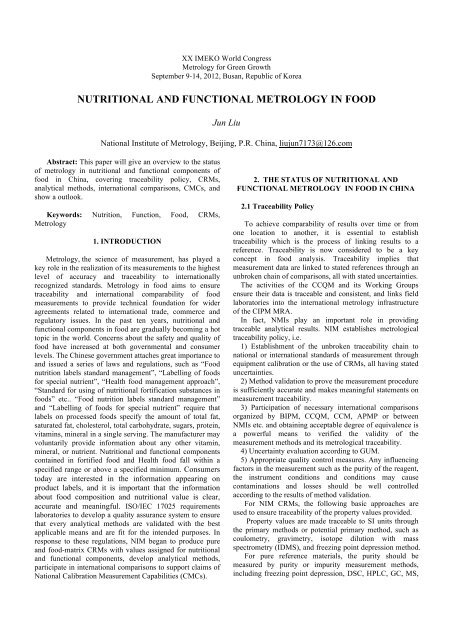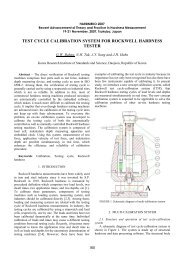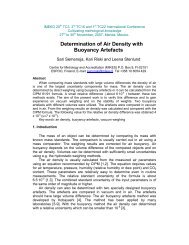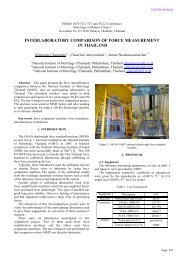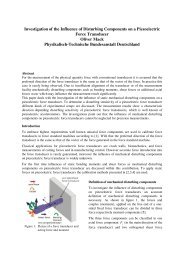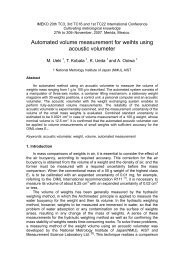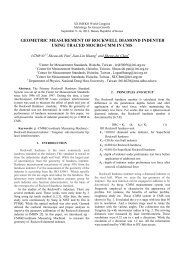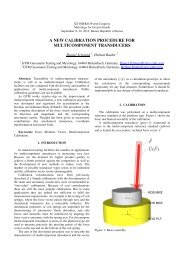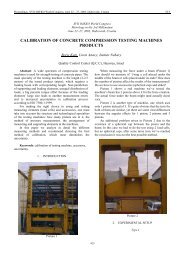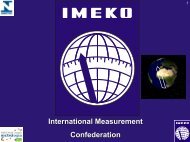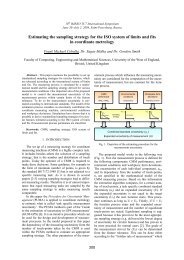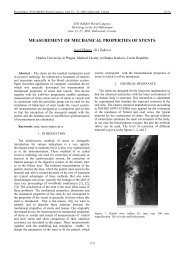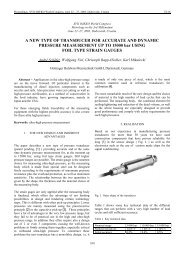NUTRITIONAL AND FUNCTIONAL METROLOGY IN FOOD - imeko
NUTRITIONAL AND FUNCTIONAL METROLOGY IN FOOD - imeko
NUTRITIONAL AND FUNCTIONAL METROLOGY IN FOOD - imeko
You also want an ePaper? Increase the reach of your titles
YUMPU automatically turns print PDFs into web optimized ePapers that Google loves.
XX IMEKO World Congress<br />
Metrology for Green Growth<br />
September 9-14, 2012, Busan, Republic of Korea<br />
<strong>NUTRITIONAL</strong> <strong>AND</strong> <strong>FUNCTIONAL</strong> <strong>METROLOGY</strong> <strong>IN</strong> <strong>FOOD</strong><br />
Jun Liu<br />
National Institute of Metrology, Beijing, P.R. China, liujun7173@126.com<br />
Abstract: This paper will give an overview to the status<br />
of metrology in nutritional and functional components of<br />
food in China, covering traceability policy, CRMs,<br />
analytical methods, international comparisons, CMCs, and<br />
show a outlook.<br />
Keywords: Nutrition, Function, Food, CRMs,<br />
Metrology<br />
1. <strong>IN</strong>TRODUCTION<br />
Metrology, the science of measurement, has played a<br />
key role in the realization of its measurements to the highest<br />
level of accuracy and traceability to internationally<br />
recognized standards. Metrology in food aims to ensure<br />
traceability and international comparability of food<br />
measurements to provide technical foundation for wider<br />
agreements related to international trade, commerce and<br />
regulatory issues. In the past ten years, nutritional and<br />
functional components in food are gradually becoming a hot<br />
topic in the world. Concerns about the safety and quality of<br />
food have increased at both governmental and consumer<br />
levels. The Chinese government attaches great importance to<br />
and issued a series of laws and regulations, such as “Food<br />
nutrition labels standard management”, “Labelling of foods<br />
for special nutrient”, “Health food management approach”,<br />
“Standard for using of nutritional fortification substances in<br />
foods” etc.. “Food nutrition labels standard management”<br />
and “Labelling of foods for special nutrient” require that<br />
labels on processed foods specify the amount of total fat,<br />
saturated fat, cholesterol, total carbohydrate, sugars, protein,<br />
vitamins, mineral in a single serving. The manufacturer may<br />
voluntarily provide information about any other vitamin,<br />
mineral, or nutrient. Nutritional and functional components<br />
contained in fortified food and Health food fall within a<br />
specified range or above a specified minimum. Consumers<br />
today are interested in the information appearing on<br />
product labels, and it is important that the information<br />
about food composition and nutritional value is clear,<br />
accurate and meaningful. ISO/IEC 17025 requirements<br />
laboratories to develop a quality assurance system to ensure<br />
that every analytical methods are validated with the best<br />
applicable means and are fit for the intended purposes. In<br />
response to these regulations, NIM began to produce pure<br />
and food-matrix CRMs with values assigned for nutritional<br />
and functional components, develop analytical methods,<br />
participate in international comparisons to support claims of<br />
National Calibration Measurement Capabilities (CMCs).<br />
2. THE STATUS OF <strong>NUTRITIONAL</strong> <strong>AND</strong><br />
<strong>FUNCTIONAL</strong> <strong>METROLOGY</strong> <strong>IN</strong> <strong>FOOD</strong> <strong>IN</strong> CH<strong>IN</strong>A<br />
2.1 Traceability Policy<br />
To achieve comparability of results over time or from<br />
one location to another, it is essential to establish<br />
traceability which is the process of linking results to a<br />
reference. Traceability is now considered to be a key<br />
concept in food analysis. Traceability implies that<br />
measurement data are linked to stated references through an<br />
unbroken chain of comparisons, all with stated uncertainties.<br />
The activities of the CCQM and its Working Groups<br />
ensure their data is traceable and consistent, and links field<br />
laboratories into the international metrology infrastructure<br />
of the CIPM MRA.<br />
In fact, NMIs play an important role in providing<br />
traceable analytical results. NIM establishes metrological<br />
traceability policy, i.e.<br />
1) Establishment of the unbroken traceability chain to<br />
national or international standards of measurement through<br />
equipment calibration or the use of CRMs, all having stated<br />
uncertainties.<br />
2) Method validation to prove the measurement procedure<br />
is sufficiently accurate and makes meaningful statements on<br />
measurement traceability.<br />
3) Participation of necessary international comparisons<br />
organized by BIPM, CCQM, CCM, APMP or between<br />
NMIs etc. and obtaining acceptable degree of equivalence is<br />
a powerful means to verified the validity of the<br />
measurement methods and its metrological traceability.<br />
4) Uncertainty evaluation according to GUM.<br />
5) Appropriate quality control measures. Any influencing<br />
factors in the measurement such as the purity of the reagent,<br />
the instrument conditions and conditions may cause<br />
contaminations and losses should be well controlled<br />
according to the results of method validation.<br />
For NIM CRMs, the following basic approaches are<br />
used to ensure traceability of the property values provided.<br />
Property values are made traceable to SI units through<br />
the primary methods or potential primary method, such as<br />
coulometry, gravimetry, isotope dilution with mass<br />
spectrometry (IDMS), and freezing point depression method.<br />
For pure reference materials, the purity should be<br />
measured by purity or impurity measurement methods,<br />
including freezing point depression, DSC, HPLC, GC, MS,
Karl Fischer titration, thermogravimetry analysis etc..<br />
For matrix reference materials, these factors including<br />
sampling, identify, extraction, sample cleanup are very<br />
important.<br />
Certified values are typically assigned on the basis of a<br />
combination of results from two or more independent<br />
methods. Certified values can also be assigned by<br />
combining data with data provided by collaborating<br />
laboratories.<br />
2.2 CRMs<br />
By the end of Sept, 2011, more than 150 CRMs for food<br />
including calibration standards, pure and matrix CRMs are<br />
produced in China. More than 40 CRMs have values<br />
assigned for elemental components in food–matrics<br />
including cabbage, spinach, apple, bean, garlic powder,<br />
laver, spirulina, pollen, ginseng, astragalus, cushaw powder,<br />
carrot, green tea, rice flour, wheat flour, corn flour, soybean<br />
flour, pork muscle, chicken, milk power, bovine muscle<br />
powder, egg yolk powder etc.. About 90 organic nutritional<br />
and functional components in RM and CRMs have been<br />
developed. These materials have been value assigned using<br />
a combination of LC-UV, CE, DSC, LC/MS, and<br />
LC/MS/MS methods, or using a single method by<br />
collaborating laboratories.<br />
Isotope dilution liquid chromatography–mass<br />
spectrometry (IDMS) method was developed to assign the<br />
value of GBW10037 which for nicotinamide in infant<br />
formula. And, more IDMS methods were used in CCQM<br />
k62 international comparison and to assign the values for<br />
GBW(E)100227 vitamins. The CRM including vitamin B 1 ,<br />
vitamin B 2 , vitamin B 6 , nicotinic acid and 10 inorganic<br />
elements in infant formula is developed primarily for the<br />
determination of inorganic and organic components in China.<br />
The GBW(E)100227 of multivitamin/multielement tablet<br />
has been completed which has values assigned for ten<br />
elements and four vitamins, and IDMS methods developed<br />
as part of certification efforts were used to assign vitamin<br />
concentrations.<br />
Five of the materials, GBW(E)100126 crude protein in<br />
whole wheat, GBW(E)100127 crude fat in whole wheat,<br />
GBW(E)100128 crude fiber in whole wheat,<br />
GBW(E)100009 nutritious compositions-containing protein,<br />
starch, total amino acid and individual amino acids in rice<br />
flour, GBW(E)100010 nutritious compositions-containing<br />
protein, starch, total amino acid and individual amino acids<br />
in wheat flour, were provided for the calibration of protein,<br />
fiber and amino acid in foodstuff. The GBW10030 has value<br />
assigned for cholesterol in egg yolk powder. Certified values<br />
are assigned for fatty acid in six edible oil, i.e.<br />
GBW(E)100120 soya bean oil, GBW(E)100121 colaz oil,<br />
GBW(E)100122 peanut oil, GBW(E)100123 sunflower oil,<br />
GBW(E)100124 corn oil, GBW(E)100125 sesame.<br />
NIM also provided purity of nutritional and functional<br />
components CRMs, such as GBW(E)100037 melatonin,<br />
GBW(E)100038 genistein, GBW(E)100039 daidzein,<br />
GBW(E)100048 glycitein, GBW(E)090057 rutin,<br />
GBW(E)090058 gardenoside, GBW 09204 ginsenoside Rg 1 ,<br />
GBW 09205 ginsenoside Rb 1 , GBW(E)100247 ferulic acid,<br />
GBW(E)100248 apigenin, GBW10038 niacinamide, GBW<br />
10053 vitamin B 6 , GBW(E)100247 vitamin B3, BW3600<br />
vitamin B 1 , BW3601 vitamin B 2 , BW3602 vitamin B 5 ,<br />
BW3603 vitamin B 12 etc..<br />
17 kinds of individual amino acid and 17 amino acids<br />
mixture in 0.1mol/LHCl are also available.<br />
2.3 International Comparisons and CMCs<br />
Interlaboratory comparison among national metrology<br />
institutes (NMIs) is an efficient path for realizing<br />
traceability and achieving mutual recognition for<br />
measurement results. At the same time, the using methods<br />
can be validated. In recent year, CCQM have organized a<br />
number of key comparisons and pilot studies as well which<br />
focuses on food analysis. NIM has been actively<br />
participating in those CCQM comparisons. As for<br />
nutritional and functional components of key comparisons,<br />
i.e., CCQM-K56, Cu, Zn, Ca, Fe in Nonfat Soybean Powde,<br />
CCQM-K60 Total Se and selenomethionine in selenised<br />
wheat flour, CCQM-K62 Nutrients in infant formula, NIM’s<br />
results are all within the degree of equivalence.<br />
CMCs mean calibration and measurement capability.<br />
NIM has about 40 CMCs in nutritional and functional<br />
components in food analysis and high purity published in<br />
BIPM KCDB by the end of 2010.<br />
2.4 In Progress and Future activities<br />
More than 20 pure materials and 3 food-matrix materials<br />
are currently being developed. These pure CRM candidates<br />
include fatty acid, nucleotide, amino acid, antioxidant<br />
material and the like. Production of CRMs for health foods<br />
is continuing. Suites(i.e. pure, extract and nature-matrix) of<br />
CRMs for the following botanicals are being developed:<br />
Panax quinquefolius, Epimedium brevicornum Maxim., and<br />
Scutellaria baicalensis Georgi.<br />
3. OUTLOOK<br />
The new developments in food science and technology<br />
provide more opportunities and challenges to nutritional and<br />
functional metrology. In recent years, there are increasing<br />
requirements for metrology in the field of nutrition and<br />
function, e.g.. evaluation of impact of nutritional and<br />
functional food to human being. Therefore, studying and<br />
establishing measurement methods of higher order, and<br />
enhancing the quality of traceability are the arduous work<br />
for nutritional and functional metrology.<br />
To meet these needs, NIM should take actions: 1) further<br />
improving the quality assurance system, 2) developing new<br />
reference methods to characterize property of pure, foodmatrix,<br />
nature-matrix materials, and 3) developing high<br />
level CRMs of food-matrix and nature-matrix.


